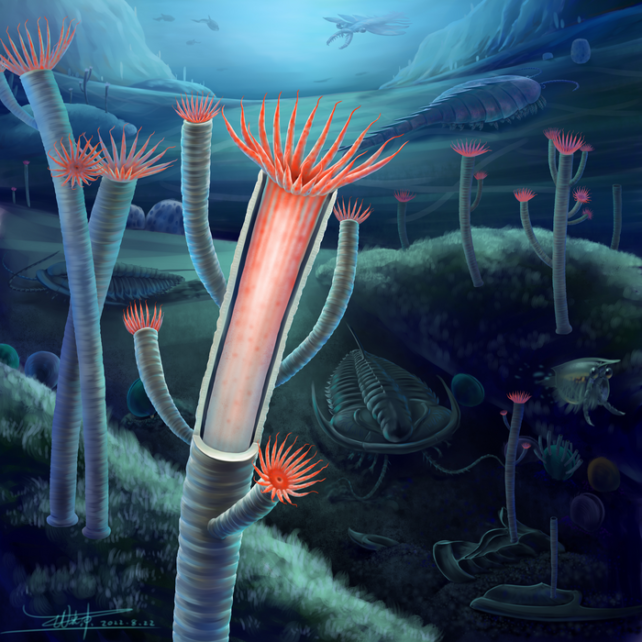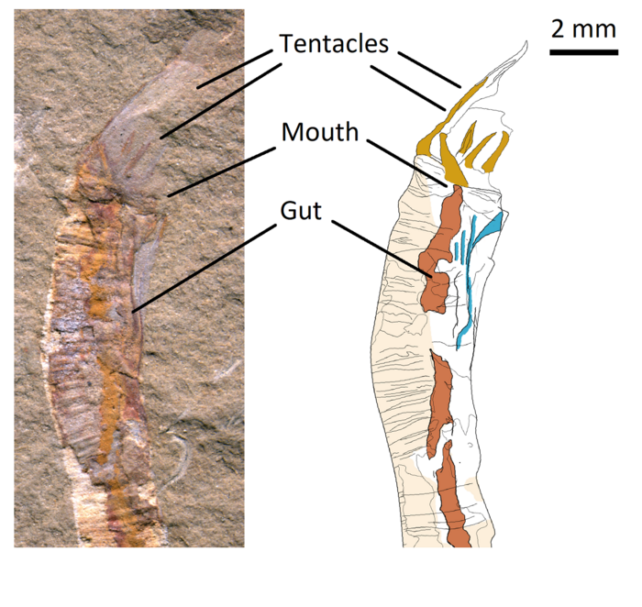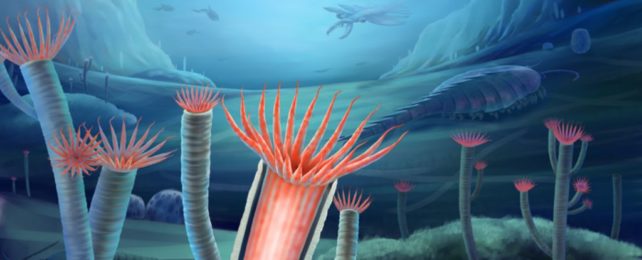Before life on Earth exploded in diversity some 540 million years ago, the first primitive animal skeletons were already starting to form.
Squishy-looking marine sponges from this time have been found in tubular thimble-like shapes, structured by hard, mineralized threads – specimens that are thought to be among the earliest assemblages of skeletal fossils.
Yet few other early skeletons exist in the fossil record, and many lost their soft parts long ago. As a result, it's hard to say what Earth's first skeletal creatures once looked like beyond hollow tubes – and even harder to classify them.
Several fortuitous fossils from China have defied the odds and are now providing archeologists with a real glimpse into early lifeforms that lived about 514 million years ago.
The fossils have preserved the soft tissue of four worm-like marine creatures belonging to the species Gangtoucunia aspera.
Initially, scientists thought this extinct genus was a relative of living annelid worms (such as earthworms), which are horizontally segmented. However, these new results suggest Gangtoucunia is more closely related to polyp cnidarians, like jellyfish, sea anemones, and coral.
The mouths of these tube-shaped organisms are ringed by retractable tentacles roughly 5 millimeters (0.2 inches) long, which were probably used to capture prey. Meanwhile, their gut takes up most of the body and is partitioned into longitudinal cavities.
The actual shape of the creatures is externally molded by a hard mineral known as calcium phosphate, which is also found in human bones.
"This really is a one-in-million discovery. These mysterious tubes are often found in groups of hundreds of individuals, but until now, they have been regarded as 'problematic' fossils because we had no way of classifying them," says paleobiologist Luke Parry from the University of Oxford.
"Thanks to these extraordinary new specimens, a key piece of the evolutionary puzzle has been put firmly in place."

Researchers discovered all four fossils in the eastern Yunnan Province of China, where a lack of oxygen has allowed soft tissue to evade hungry bacteria.
The crown of tentacles seen on the top of these primitive polyps is only known to occur among polyp cnidarians, including jellyfish before they develop a free-swimming stage.
As young polyps, jellyfish are shaped like vases, with one end attached to a surface and the other end open to the ocean world. Tentacles at the entrance help snag prey and pop them into the mouth.
In light of these results, researchers concluded that G. aspera is an ancient seabed polyp either within or proximal to a cnidarian subclade known as medusozoa.
Most animals in this subclade, so-called true jellyfish (scyphozoans), ultimately develop free-swimming abilities, but some, like a few species of hydrozoa, remain polyps their whole lives. Colonies of hydrozoa polyps can build skeletons similar to the G. aspera fossils, too.
"Intriguingly," the authors note, "we do not recover a close relationship between Gangtoucunia in a clade with other medusozoans with calcium phosphate exoskeletons, suggesting that tube-building materials could have a complex early evolutionary history, possibly due to convergent losses and reduction of calcium phosphate in skeletons as it became less available through the Palaeozoic."
In other words, external skeletons probably didn't arise just once but probably evolved several times in multiple different lineages.

The diversification of the animal skeleton might have been a big driver behind the Cambrian explosion itself. Yet the sudden appearance of structural diversity in the fossil record may also speak to how hard it is for thin threads of biominerals to stand the test of time.
Even from the little evidence scientists have found, it is clear that tube-shaped animals were popping up before the explosion of animal diversity that once took our life by storm. What triggered their expansion remains an open question, though predation is one possibility.
"A tubicolous mode of life seems to have become increasingly common in the Cambrian, which might be an adaptive response to increasing predation pressure in the early Cambrian," says paleobiologist and study author Xiaoya Ma from Yunnan University in China and the University of Exeter in the UK.
"This study demonstrates that exceptional soft-tissue preservation is crucial for us to understand these ancient animals."
The study was published in the Proceedings of the Royal Society B Biological Sciences.
